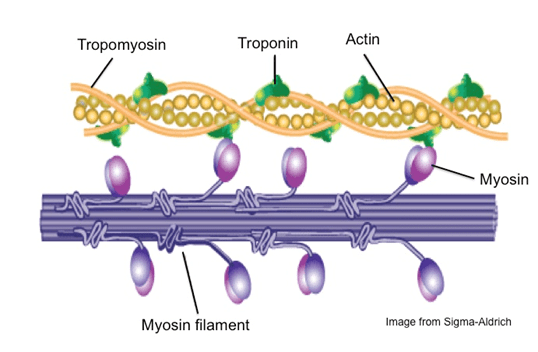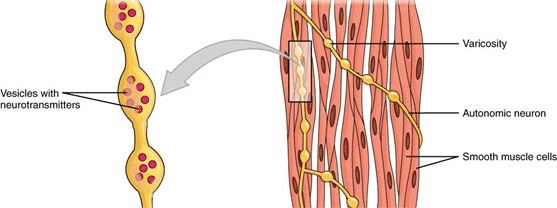Muscle: Sliding Filament Theory & Contractile Proteins | Biology Class 11 - NEET PDF Download
Sliding Filament Theory of Muscle Contraction
The mechanism of muscle contraction is explained by the sliding filament model. This theory was proposed by H.E Huxley and J. Hanson, and A. F. Huxley and R. Niedergerke in 1954.
The arrangement of actin and myosin myofilament within a sarcomere is crucial in the mechanism of muscle contraction. It is proposed that muscle contracts by the actin and myosin filaments sliding past each other. For an analogy, muscle contraction by sliding filament model is equivalent to interlocking fingers, pushing them together shortens the distance.
As sarcomere is the unit of muscle contraction, its length contracts resulting in whole muscle contraction. During contraction, the length of A-band (Dark band) remains the same whereas the length of I-band (Light band) and H-zone gets shorter.
Actin Myofilament
- An actin myofilament is made up of actin molecule, tropomyosin and troponin complex. Troponin is composed of three sub-units (troponin I, T and C). Tropomyosin form two helical strands which are wrapped around actin molecules (G-actins) longitudinally in thin twisted stranded form.
- Each G-actin is attached to an ATP molecule. The whole assembly of actin molecules is known as F-actin (Fibrous actin).
- Tropomyosin switches ON or OFF the muscle contraction mechanism.
- Troponin complex is a globular protein which binds to tropomyosin and calcium ions.
Myosin Myofilament
- A myosin myofilament consists of two distinct regions, a long rod-shaped tail called myosin rod and two globular intertwined myosin heads.
- The globular head appears at intervals along the myosin myofilament, projecting from the sides of the filament.
- The myosin head can attach to the neighbouring acting filament where actin and myosin filaments overlap.
 Actin and Myosin Myofilament
Actin and Myosin Myofilament
Mechanism of Muscle Contraction
When the nerve impulse from the brain and spinal cord are carried along motor neurons to the neuromuscular junction, Ca++ ions are released in the terminal axon. Increases calcium ion concentration stimulates the release of neurotransmitters (Acetylcholine) in the synaptic cleft. The neurotransmitter binds to the receptor on the sarcolemma and depolarization and generates action potential across muscle fibre for muscle contraction. The action potential propagates over the entire muscle fibre and moves to the adjacent fibres along transverse tubules. The action potential in transverse tubules causes the release of calcium ion from the sarcoplasmic reticulum, which stimulate for muscle contraction.
The sequences of muscle contraction explained by sliding filament theory are as follows:
 Diagrammatic Representation of Muscle Contraction Mechanism
Diagrammatic Representation of Muscle Contraction Mechanism
1. Blocking of the myosin head
- Actin and myosin overlap each other forming a cross bridge. The cross-bridge is active only when the myosin head attached like a hook to the actin filament.
- When a muscle is at rest, the overlapping of actin filament to the myosin head is blocked by tropomyosin. The actin myofilament is said to be in OFF position
2. Release of calcium ions
- Nerve impulse causing depolarization and action potential in the sarcolemma triggers the release of calcium ions from the sarcoplasmic reticulum.
- The calcium ion then binds with the troponin complex on the actin myofilament causing displacement of troponin complex and tropomyosin from its blocking site exposing the myosin binding site.
- As soon as the myosin binding site is exposed, the myosin head cross-bridge with actin filament. Now, the actin myofilament is said to be in the ON position.
3. Active cross-bridge formation
- When the myosin head attached like hooks to the neighbouring actin filament, an active cross-bridge is formed. The cross-bridge between actin and myosin filament acts as an enzyme (Myosin ATPase).
- The enzyme Myosin ATPase hydrolyses ATP stored into ADP and inorganic phosphate and releases energy. This released energy is used for the movement of the myosin head toward actin filament. The myosin head tilts and pulls actin filament along so that myosin and actin filament slide each other. The opposite end of actin myofilament within a sarcomere move toward each other, resulting in muscle contraction.
- After sliding the cross-bridge detached and the actin and myosin filament come back to their original position. The active cross-bridge form and reform for 50-100 times within a second using ATP in a rapid fashion. Therefore, muscle fibre consists of numerous mitochondria.
- In muscle contraction, the sarcomere can contract by 30-60% of its length
 Contractile Proteins
Contractile Proteins
Skeletal muscle is composed of muscle fibres which have smaller units called myofibrils. There are three types of proteins that make up each myofibril; they are contractile, regulatory and structural proteins. By contractile proteins, we mean actin (thin filament) and myosin (thick filament). Each actin filament is composed of two helical “F” actin (filamentous actin) and each ‘F’ actin is made up of multiple units of ‘G’ actin. Along with the ‘F’ actin, two filaments of regulatory proteins tropomyosin and troponin at regular intervals are present. During muscle relaxation, troponin covers the binding sites for myosin on actin filaments. Muscle Contraction
Muscle Contraction
Each myosin is composed of multiple units of meromyosin which has two important parts- a globular head known as heavy meromyosin with a short arm and a tail known as light meromyosin. The head and arms project at regular distance and angle from each other from the surface of myosin filament and are known as the cross arm. The head bears binding sites for ATP and active sites for actin. Let us now try to understand the muscle contraction mechanism.
|
150 videos|399 docs|136 tests
|
FAQs on Muscle: Sliding Filament Theory & Contractile Proteins - Biology Class 11 - NEET
| 1. What is the sliding filament theory of muscle contraction? |  |
| 2. What are contractile proteins in muscle? |  |
| 3. How does the sliding filament theory explain muscle contraction? |  |
| 4. What is the significance of the sliding filament theory in understanding muscle function? |  |
| 5. What happens to the actin and myosin filaments during muscle contraction according to the sliding filament theory? |  |

















